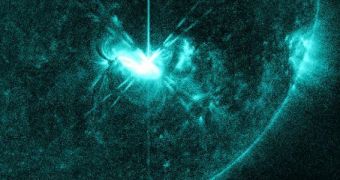As the Sun approaches a new maximum in its 11-year cycle, it is beginning to produce an increased number of solar flares and coronal mass ejection. July 4 was no exception, as data provided by the NASA Solar Dynamics Observatory (SDO) can confirm.
The sensitive instruments aboard the spacecraft were able to detect an M5.3-class solar flare forming on the surface of the Sun early on Wednesday. The event peaked at 5:55 am EDT (0955 GMT), and then slowly subsided.
The photo above is collected at a wavelength of 131 Angstrom, which is especially well suited for observing the highly-charged particles streaming out of the solar surface. SDO is capable of conducting crystal-clear observations at these frequencies.
The telescope launched on February 11, 2010, aboard an ULA Atlas V rocket, from the Space launch Complex 41 (SLC-41) at the Cape Canaveral Air Force Station (CCAFS), in Florida.

 14 DAY TRIAL //
14 DAY TRIAL //